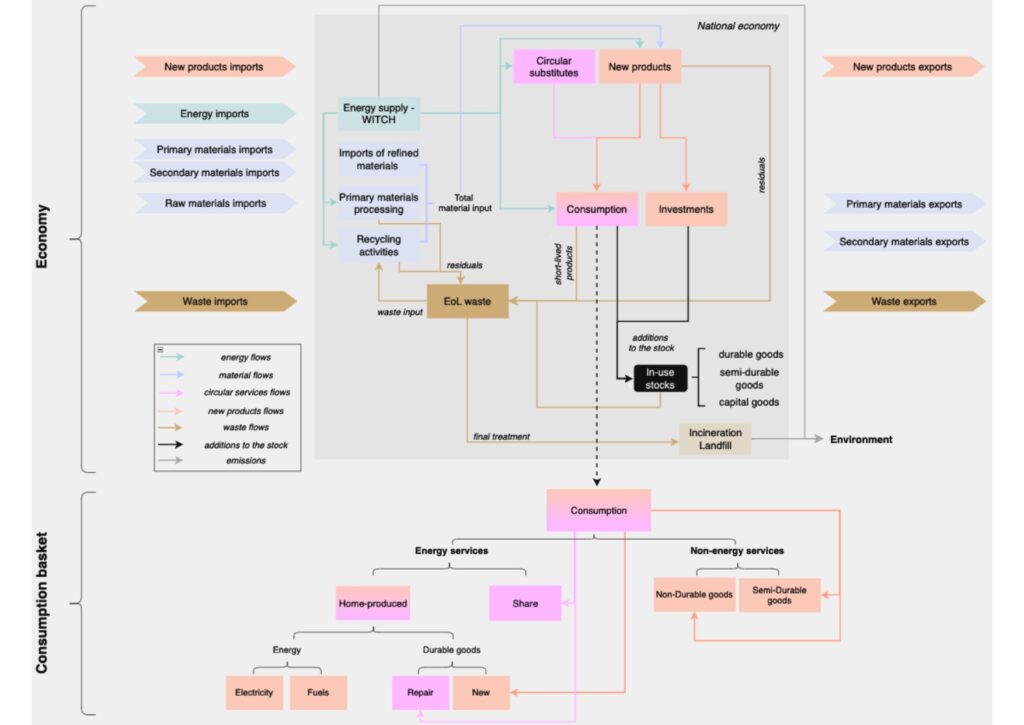Darius Corbier, Junior Scientist, RFF-CMCC European Institute on Economics and the Environment
As transitioning to a circular economy (CE) can contribute to the achievement of long-term climate targets, the need for models to evaluate CE policy impacts becomes increasingly important. Assessing the full potential of a CE requires a macro-level and integrated assessment approach that addresses the inter-dependencies and trade-offs between environmental, social, and economic objectives. CIRCEE, the CIRCular Energy-Economy Model, is a model designed to include behavioral, industrial ecology and economic concepts to assess the impacts of CE policies on socioeconomic systems, resource use, waste generation and CO2 emissions.
The CIRCEE model
CIRCEE is a deterministic dynamic and stochastic general equilibrium model designed to incorporate industrial ecology principles such as material flows and stock-consistent resource accounting (Corbier et al., 2024a) (refer to Figure 1). It also addresses behavioral heterogeneity by analyzing how different household lifestyles respond to CE policies by soft-linking CIRCEE to the LIFE model of Pettifor et al. (2023)b.

Applications
In its current version, CIRCEE is designed to focus on consumer behaviors in response to specific CE policies aimed at fostering Repair, Reuse, Rethink and Refuse strategies. Future developments will focus on incorporating endogenous green product design, providing a more detailed assessment of how policies drive innovation in sustainability.
One of CIRCEE’s applications assesses the effects of increasing Extended Producer Responsibility (EPR) fees for energy-using durable goods. These fees can incentivize households to shift from purchasing new products to engaging in circular activities like repairing and sharing. CIRCEE’s simulations reveal that higher EPR fees can reduce material use and waste generation while promoting resource-efficient behaviors. However, the model also highlights potential trade-offs. For example, greater reliance on shared services may increase energy consumption, partially offsetting the environmental benefits.
Key Messages
The model highlights the importance of considering synergies and trade-offs across CE strategies. It demonstrates how policies like EPR fees can nudge consumers toward sustainable practices while highlighting the risks of rebound effects on resource and energy use. These insights are important for policymakers aiming to design effective CE policies.
This news is part of a project that has received funding from the European Union’s Horizon Europe programme under grant agreement No 101081604 – PRISMA.
Views and opinions expressed are however those of the speaker(s) only and do not necessarily reflect those of the European Union or the European Climate, Infrastructure and Environment Executive Agency (CINEA). Neither the European Union nor the granting authority can be held responsible for them.
a Corbier, D., Pettifor, H., Agnew, M., & Drouet, L. CIRCEE, the CIRCular Energy Economy model: Bridging the gap between economic and industrial ecology concepts. Journal of Industrial Ecology.
b Pettifor, H., Agnew, M., & Wilson, C. (2023). A framework for measuring and modelling low-carbon lifestyles. Global Environmental Change, 82, 102739.
